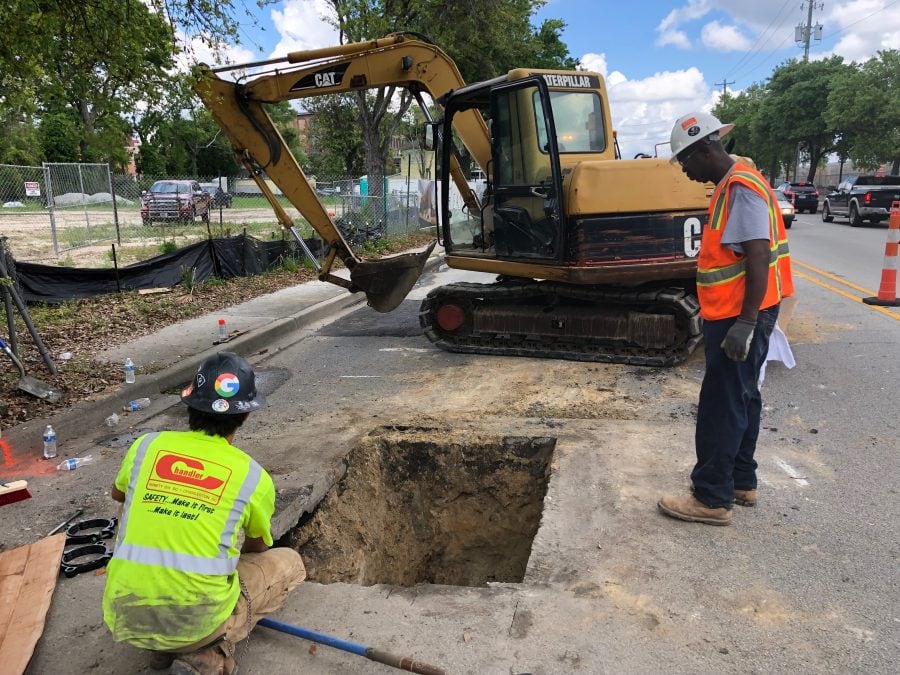Many factors go into the preparation of a job site before building and development can begin, involving a range of different preparatory tasks depending on the condition of the site’s environment. The term “sitework” encompasses all preliminary steps taken to prepare a job site for construction.
As part of Live Oak Contracting’s general contracting services, our team works diligently to ensure all projects are set up for long-term success. But despite our experts’ due diligence, sometimes unforeseen conditions can arise from lack of quality as-built records or inaccurate plans.
Ahead, we break down the basics of sitework, it’s importance, and how the Live Oak team, with the help of Chandler Construction, overcame unexpected site conditions at the 655 East Bay project in Charleston, South Carolina.
Six factors that make-up good sitework
There are six essential aspects of sitework common to most construction sites: clearing and grubbing, subgrade stabilization, heavy haul roads, shoring and erosion control, excavation, drainage, and water systems. When these procedures are completed with accuracy, they prevent future challenges and project slowdowns, save money, ensure the stability of the build, and provide a safe construction environment.
Clearing and Grubbing: Clearing and grubbing refer to the defoliation of vegetation as well as other debris from a site. The size and type of vegetation, predetermined depth of the foundation, state regulations, environmental factors, and disposal method are all addressed during this initial step.
Shoring and Erosion Control: Shoring and erosion control ensures the safety, materials, equipment, and integrity of a project is protected from weathering and collapse. The type of method is determined by environmental factors.
Hauling Roads: These roads are created to ensure safe access to the construction site to prevent heavy equipment and vehicles from being damaged or getting stuck. Volume, size, weight, and types of vehicles and machinery are all factored into the design of hauling roads and vary by project.
Subgrade Stabilization: This process is done to prevent the ground from shifting or caving throughout construction and involves stabilizing the soil levels below the topsoil. Soil samples are taken to determine the best procedure which usually consists of mixing a stabilizing agent, such as cement, with the soil to make it stronger.
Excavation: The process of excavation involves using large earthmoving equipment to remove soil and rock from an area that will be used for something else on a project site. Soil, rock type and depth of excavation are all factors that affect the method of excavation.
Drainage and Water systems: Drainage systems clear stormwater from the site while water systems bring safe water into the site. These systems are essential because most every construction project needs a method to push wastewater out while clean water is brought in.
Live Oak Contracting addresses unforeseen conditions at 655 East Bay in Charleston, South Carolina
It is typical for a historical city with antiquated infrastructure to have relatively poor as-built records. Oftentimes, this leads to unexpected site conditions and a lengthy permit revision process when uncovering buried facilities that have existed for centuries. 655 East Bay Street in Charleston, SC was no exception.
 The first complication to arise surrounded the permitting and approval process. After redesigning the sanitary collection improvements, new plans had to be approved by the local utility department, owner, and the city of Charleston. This led to 10 civil plan revisions and considerable effort by the project team in tracking the changes related to the work. With each revision came new conflicts and subsequent approvals were lengthy resulting in the schedule to continue to slip. The ongoing revisions to the utility design led to other sitework-related delays that impacted the entire project timeline.
The first complication to arise surrounded the permitting and approval process. After redesigning the sanitary collection improvements, new plans had to be approved by the local utility department, owner, and the city of Charleston. This led to 10 civil plan revisions and considerable effort by the project team in tracking the changes related to the work. With each revision came new conflicts and subsequent approvals were lengthy resulting in the schedule to continue to slip. The ongoing revisions to the utility design led to other sitework-related delays that impacted the entire project timeline.
The project team encountered another hurdle when it was discovered the physical location of the existing cast iron water main within the East Bay Street right-of-way conflicted with the planned location of the sanitary sewer improvements. The team had to continue with exhaustive exploratory excavation until the water main was located 6 feet east of where previously identified. Furthermore, due to logistical considerations, the depth of new facilities increased resulting in a linear construction schedule leaving less room for flexibility.
These unexpected challenges disrupted the sitework schedule. With added costs as a result of these setbacks mounting, the project team worked diligently to develop a solution.
The strategy required for various phases of sanitary and other underground utility work to be partially constructed and commissioned rather than waiting for 100% completion. Storm system installation will begin once the utilities are approximately 30% complete and will continue in parallel with the remaining work.
While these delays ultimately added time and costs to the project, Live Oak Contracting worked with Chandler Construction to mitigate the extent of the impacts resulting from the unforeseen conditions.
“Navigating a complex web of buried facilities and unknown underground obstructions is a unique site work challenge in most historic settings. The project team worked in a collaborative fashion to reduce delays, minimize cost overruns and produce a schedule that was realistic for other trades who were impacted by the seemingly endless design revisions,” said Matt Barres of Chandler Construction.




